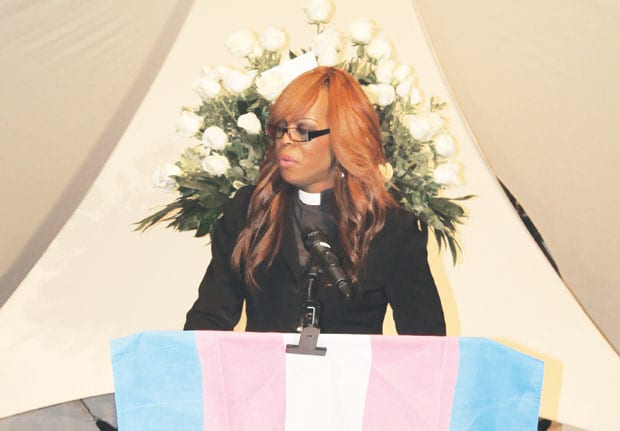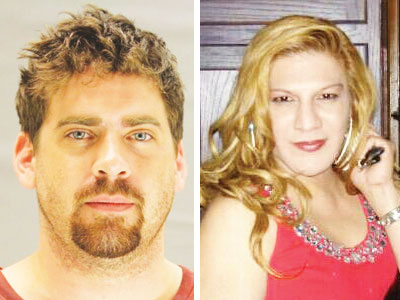TDOR events Sunday in Dallas wilal memorialize the at least 71 trans women and men murdered in the last year

JUSTICE NOT SERVED | Jonathan Kenney, below left, has a Jan. 22 court date on charges related to the death of Janette Tovar, below right. The Rev. Carmarion Anderson, above, is keynote speaker at services Sunday honoring trans women and men who were killed in the last year. MosaicSong, bottom, will perform.
Janette Tovar died on Oct. 15, 2012, at the age of 43. Her boyfriend, Jonathan Stuart Kenney, 27, allegedly assaulted her.
Witnesses saw the couple fighting early in the morning in the 800 block of West Davis Street in Oak Cliff. Kenney allegedly slammed Tovar’s head against concrete. After they returned to their home in the 900 block of W. Eighth Street, three blocks away, he allegedly continued to assault her.
Hours later, Kenney found her unresponsive and called 911.
Kenney provided a statement to the police admitting that he slammed Tovar’s head into the concrete and continued assaulting her at home.
Although Kenney was originally arrested on murder charges, the charges were lowered to assault because prosecutors did not feel they had the evidence to prove murder. Kenney has a court date set for Jan. 22.
Before her death, Tovar told friends about the violence at home. Friends said they had seen the couple argue, but had not witnessed violence. Others said they didn’t want to get involved in a murder.
One, who was with the couple the night before the assault, was engaged and not supposed to be out that night. She was worried about her own relationship and declined to answer questions.
So rather than get involved, people let someone who allegedly killed their friend get away with murder.
Tovar was transgender, and unfortunately, those who assault and kill trans women and men get away with it far too often.
While Tovar’s death was tragic and her killer isn’t likely to be convicted of her murder, we do know what happened. But in most trans murders, the cases remain unsolved. And in many places, the cases are hardly investigated.
But that doesn’t mean the victims are not remembered and honored. This year, Thursday, Nov. 20 is Transgender Day of Remembrance. Events in Dallas to honor TDOR will be held Sunday, Nov. 16.
Gwen Smith, a trans woman, held the first Transgender Day of Remembrance in 1999 to remember Rita Hester, another trans woman who was murdered a year earlier.
Hester was a trans activist who lived in Boston. On Nov. 28, 1998, she was attacked in her own apartment and stabbed 20 times. A neighbor called police and Hester was rushed to the hospital, but she died just after she was admitted.
Hester’s murder — like the murders of so many other transgender people — remains unsolved.
Since then, TDOR remembrances have taken place around the world. The ceremonies include a memorial to trans people who have been killed since the last TDOR commemoration.
This year’s list includes 71 names so far.
The cause of death is often violent — the trans victims are stoned to death, thrown from moving vehicles, run over, dismembered, pushed off a moving train.
Some of the victims are simply listed as “unknown woman.”
One unknown woman was found in Sao Paolo, Brazil with her eyes removed.
Two transgender women were murdered in Baltimore in June. Both died of massive trauma. One woman’s body was left in a field. Two weeks later, the other was found in an alley.
Last December, two trans women were killed in Cleveland one day apart. One died of a gunshot to the head, the other of blunt force trauma to the head.
An eight-year-old trans girl was beaten to death by her father for refusing to cut her hair, liking women’s clothing and dancing.
Of the transgender murders that took place in the U.S. over the last 12 months, none seems to have been solved.
Local TDOR Chair Oliver Blumer said a local trans woman who died recently will be remembered.
“This year we’re memorializing a young trans woman from Euless who was bullied and committed suicide,” Blumer said.
He said the woman was 18 and still in high school. She changed schools, but the bullying continued until, in May, she took her own life.
Before the 7 p.m. service at Cathedral of Hope, a candlelight vigil takes place on The Strip on Cedar Springs.
Participants in the vigil will meet at Cathedral at 5 p.m. and then drive in groups down Cedar Springs. At 5:45, they will begin to line the street and light candles. They’ll be silent and direct any questions to volunteers along the route, said GEAR coordinator Blair High. At 6:30 p.m., the vigil ends and participants return to Cathedral for the service.
Blumer said doors open for the memorial service at 6:30 p.m.
Because so many of the trans victims this year are from Brazil, he said, one of the people reading names is a Portuguese speaker.
Carmarion Anderson is the keynote speaker. MosaicSong and The Transcontinentals will perform.
High said personal safety is something the trans community takes very seriously. She said she hesitates before planning anything outside of the city.
“If there’s a concert at Winstar I want to go to, I think twice,” she said. “There’s a chance I could get hurt going to Oklahoma.”
The Transgender Law and Policy Institute complied some statistics of the rates of violence and discrimination against the trans community.
Among trans woman, 83 percent reported verbal abuse and 37 percent experienced physical abuse because of their gender identity or expression.
Discrimination is also rampant. Housing discrimination was reported by 37 percent of trans women and employment discrimination by 46 percent. One in five trans women is without stable housing or is homeless and 52 percent are without health insurance.
Trans men reported similar treatment.
Verbal abuse was reported by 85 percent of trans men and 30 percent experienced physical violence.
Employment discrimination was reported by 57 percent and housing discrimination by 20 percent. Fifteen percent were without stable housing or were homeless and 41 percent had no health insurance.
This article appeared in the Dallas Voice print edition November 14, 2014.















